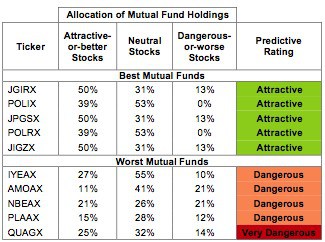The large-cap growth style ranks fourth out of the twelve fund styles as detailed in my Style Rankings for ETFs and Mutual Funds report. It gets my Neutral rating, which is based on aggregation of ratings of 23 ETFs and 694 mutual funds in the large-cap growth style as of February 6th, 2013. Prior reports on the best & worst ETFs and mutual funds in every sector and style are here.
Figures 1 and 2 show the five best and worst-rated ETFs and mutual funds in the style. Not all large-cap growth style ETFs and mutual funds are created the same. The number of holdings varies widely (from 18 to 574), which creates drastically different investment implications and ratings. The best ETFs and mutual funds allocate more value to Attractive-or-better-rated stocks than the worst, which allocate too much value to Neutral-or-worse-rated stocks.
To identify the best and avoid the worst ETFs and mutual funds within the large-cap growth style, investors need a predictive rating based on (1) stocks ratings of the holdings and (2) the all-in expenses of each ETF and mutual fund. Investors need not rely on backward-looking ratings. My fund rating methodology is detailed here.
Investors seeking exposure to the large-cap growth style should buy one of the Attractive-or-better rated mutual funds from Figure 2.
Get my ratings on all ETFs and mutual funds in this style on my free mutual fund and ETF screener.
Figure 1: ETFs with the Best & Worst Ratings – Top 5

Sources: New Constructs, LLC and company filings
PowerShares RAFI Fundamental Pure Large Growth Portfolio (PXLG) is excluded from Figure 1 because its total net assets (TNA) are below $100 million and do not meet our liquidity standards.
Figure 2: Mutual Funds with the Best & Worst Ratings – Top 5

Sources: New Constructs, LLC and company filings
GMO Trust: GMO US Growth Fund (GMGWX) is excluded from Figure 2 because its total net assets (TNA) are below $100 million and do not meet our liquidity standards.
Schwab U.S. Large-Cap Growth ETF (SCHG) is my top-rated large-cap growth ETF and earns my Neutral rating. JPMorgan Trust I: JPMorgan Intrepid Growth Fund (JGIRX) is my top-rated large-cap growth mutual fund and earns my Attractive rating.
First Trust Large Cap Growth AlphaDEX Fund (FTC) is my worst-rated large-cap growth ETF and earns my Neutral rating. Quaker Investment Trust: Quaker Strategic Growth Fund (QUAGX) is my worst-rated large-cap growth mutual fund and earns my Very Dangerous rating.
Figure 3 shows that 244 out of the 905 stocks (over 35% of the market value) in large-cap growth ETFs and mutual funds get an Attractive-or-better rating. However, only one out of 23 large-cap growth ETFs (less than 1% of total net assets) and 16 out of 694 large-cap growth mutual funds (less than 1% of total net assets) get an Attractive-or-better rating.
The takeaway is: mutual fund managers allocate too much capital to low-quality stocks and large-cap growth ETFs hold poor quality stocks.
Figure 3: Large-cap Growth Style Landscape For ETFs, Mutual Funds & Stocks

As detailed in “Cheap Funds Dupe Investors”, the fund industry offers many cheap funds but very few funds with high-quality stocks, or with what I call good portfolio management.
Investors need to tread carefully when considering large-cap growth ETFs and mutual funds, as only one ETF and 16 mutual funds in the large-cap growth style allocate enough value to Attractive-or-better-rated stocks to earn an Attractive rating.
SanDisk Corporation (SNDK) is one of my favorite stocks held by large-cap growth ETFs and mutual funds and earns my Very Attractive rating. This flash memory manufacturer has shown some volatility year-to-year in NOPAT, but over the longer term it has achieved a 52% compounded annual growth rate in NOPAT over the past nine years. This growth is not reflected in SNDK’s valuation of ~$49.80/share. This valuation gives it a 0.8 price to economic book value ratio, implying that the market expects a permanent 20% decline in NOPAT for SNDK. In the short term it is possible that SNDK might experience a decline in NOPAT, but over the long term it is hard to imagine this company experiencing the kind of permanent decline that its share price implies.
Ventas Inc. (VTR) is one of my least favorite stocks held by large-cap growth ETFs and mutual funds and earns my Very Dangerous rating. VTR is a prime example of a disconnect between accounting and economic earnings. Over the last two years, VTR’s NOPAT, true after tax cash flow, has declined by a total 52%. Over the same period of time, VTR’s GAAP net income has increased by 37%. Investors have trusted the latter trend, driving up VTR’s share price to ~$66.55. This valuation implies the company will grow its NOPAT at over 20% compounded annually for more than 20 years. Betting on such growth, which investors are doing by holding this stock, seems too risky even in an economy where real estate appears to be rebounding.
Figures 4 and 5 show the rating landscape of all large-cap growth ETFs and mutual funds.
My Style Rankings for ETFs and Mutual Funds report ranks all styles and highlights those that offer the best investments.
Figure 4: Separating the Best ETFs From the Worst Funds

Figure 5: Separating the Best Mutual Funds From the Worst Funds

Review my full list of ratings and rankings along with reports on all 23 ETFs and 694 mutual funds in the large-cap growth style.
Sam McBride contributed to this report.
Disclosure: David Trainer owns SNDK. David Trainer and Sam McBride receive no compensation to write about any specific stock, sector or theme.